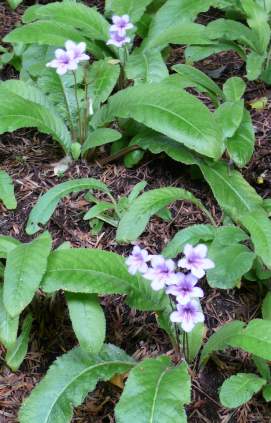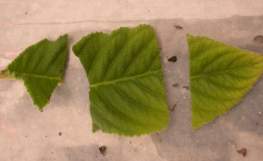Streptocarpus primulifolius
Streptocarpus primulifolius Gand.
Family: Gesneriaceae
Common names: Cape primrose
Introduction
This is one of the more striking Streptocarpus species with lovely large, trumpet-shaped flowers in deep shades of mauve with distinctive dark purple streaks in the throat.

Description
Description
Streptocarpus primulifolius is a pretty shade-loving plant, fast growing and so rewarding in the house or the garden. An unusual feature of this soft perennial is that no stems are present, each leaf is actually an individual plant with its own roots and flowering stems. Numerous rough, hairy leaves grow in a rosulate formation on quite a stout horizontal rhizomatous rootstock, each long leaf originates at ground level and extends outwards, curving gently. Large, single or paired flowers each with 5 broad, uneven petals are borne on long slender flowering stems throughout summer. The flower typically has two lips, the upper is 2-lobed and the lower 3-lobed. The long fruit capsules twist open in a spiral when dry, releasing lots of very small, light seeds.
Conservation Status
Status
Many of the Streptocarpus species are very specific in their distribution and occur in very small populations, making them vulnerable to any disturbance. Streptocarpus primulifolius does not have a rare, endangered or threatened status at the moment but S. kentaniensis, S. lilliputana and S. formosus are threatened.
Distribution and habitat
Distribution description
Streptocarpus primulifolius occurs along the coast from the Eastern Cape up to central KwaZulu-Natal, growing in damp soils on steep slopes in bush or forest, on mossy rocks or along river banks and gorges, mostly in shade or dappled light. The plants are very selective, occurring only on the shady rock sides or slopes that face south or southwest, often growing in crevices or ledges in association with lichens and moss. There are two subspecies of S. primulifolius : subsp. primulifolius with the same distribution as above - flower pale bluish outside with lower petal marked in deep violet inside with reddish purple lines; subsp. formosus from Port St Johns to Port Shepstone - flower is pale whitish blue and has a yellow streak in the throat, flecked with violet-purple streaks.
Derivation of name and historical aspects
History
Streptocarpus primulifolius which is closely related to S. rexii was first collected in 1898 by E.E. Galpin in East London. As the distribution ranges of these two species overlap in this area, natural crossing between the two are quite common.
The name Streptocarpus is derived from the Greek words, streptos, meaning twisted, and carpus meaning fruit, which is a perfect description of the plant's spirally twisted seed pods. The species name primulifolius means leaves like a primula or primrose.
Streptocarpus belongs to the same family, Gesneriaceae, as do the well-known African violets and gloxinias that are grown as potplants all over the world. This is a large family of mostly tropical and subtropical herbs, with ± 130 genera, and ± 2900 species world-wide. There are 8 genera in Africa, with the one genus, Streptocarpus in South Africa and it has ± 51 species. The family is named after Konrad Gesner. He was a Swiss scholar, and in 1963, 30 years after his death, his name was given to this family.
Ecology
Ecology
Gesneriaceae are often epiphytic (growing on trees) or lithophytic (growing on rocks). The plants can cross-pollinate easily with other species but in many instances are self-pollinated. The very small seed is wind distributed.
Uses
Use
Some species of Streptocarpus are used in Zulu medicine where leaf infusions are drunk to ease birthing pains.
There are a wonderful variety of easy to grow Streptocarpus hybrids in all shapes and sizes with really striking flower colours and forms which make very popular indoor plants.

Growing Streptocarpus primulifolius
Grow
Streptocarpus primulifolius makes a popular house plant because of the attractive flowers and foliage but also because of the long flowering period. Flower stems will also last a few days when cut for the vase. It is really easy to grow and quite robust. It will do well as a pot plant indoors or planted in a sheltered, shady spot in the garden. Ensure a warm spot with good light but no direct sunlight. Streptocarpus species in general are very sensitive to light, burned easily by the sun and flower poorly in deep shade. Light shade is best for growing healthy plants with plenty of flowers. Good ventilation is required to prevent fungal infections indoors but if grown outdoors, protect plants from any drying winds by mulching with compost or leaf mould.
Watering Streptocarpus should be done with care. It is very important that the plants should not be over-watered, to prevent rotting and fungal problems. They have quite shallow root systems-in nature they often thrive in very little soil, so allow them to get quite dry between watering; they can be allowed to wilt slightly as they have the ability to recover very well. Be aware that severe wilting can be a sign of root rot caused by over-watering, so check the soil to see that this is not the case. During the warm summers, when they are actively growing, they need plenty of water. Most of the Streptocarpus species 'rest' during winter and this slight dormancy means they need very little water during this time, so be sure to reduce the amount given.
Regularly remove all dead, unhealthy, dying leaves and flowers as these encourage fungal growth, and it also keeps the plants attractive. The tips of the leaves often die off as they get older or when stressed by drought or low temperature or when over-wintering. This unattractive tip can be cut off without harming the growth of the leaf, as it would naturally shed this through an abscission layer and continue with new growth from the base.

Regular feeding with liquid foliar feed during the growing season is recommended. Repot once the plant's roots appear at the bottom of the pot.
Streptocarpus can easily be grown from seed, but only species will come true only from seed. For hybrids, use only cuttings or division to keep all the new plants identical to the parent plant.
When sowing seeds, mix a pinch of the dust-like seeds with a small amount of sand to assist with spreading them evenly and to prevent sowing too densely. Use a well-drained medium that is not too coarse. Cover with a very thin covering of sand, keep out of direct sun but in warmth. Water regularly with a fine spray. Germination usually takes 3-4 weeks, and do not allow the seedlings to dry out.
Plant the seedlings into small pots only once they are quite big and strong. Transplant again into bigger pots when the roots have filled the small pots.
Streptocarpus can be propagated from a single leaf and the best results are from leaf cuttings taken in spring and early summer. A variety of mediums can be used as long as they are well drained. Sand, bark, palm fibre and polystyrene or vermiculite in different ratios are all suitable. At Kirstenbosch we use 40 % bark, 40 % polystyrene and 20 % sand. Water the medium well and treat with a suitable fungicide before using. Select healthy youngish leaves from the centre of the plant and cut off using a sharp knife or blade. Remember that the most active region of the leaf is near the base where the growing region (meristem) is present and so this area will yield the best rooting results. If it is a small leaf, insert the cut end of the leaf into a rooting hormone and then into the medium. Larger leaves can be cut into 3 cm strips.

Always take note of which way is the leaf cutting should be orientated before dipping into a rooting hormone and place firmly into the medium but not too deep as this will encourage rot. Alternatively, cut along either side of the midrib and treat in the same manner. Depending on the species, plantlets will form along the base of the cut in one to three months.

When the plantlets are well established, the old leaf can be teased out from the medium and the plantlets potted up, usually between 6-12 months. Plants that have grown quite large can also be divided as a method of increasing them; do this in early spring and repot to grow on. Mature plants can lose their vigour after 3 to 5 years and propagation as described above can be used to replace them with younger plants.
Worms are the most troublesome pests of Streptocarpus ; they can either be hand collected or sprayed with a suitable poison. Fungal infections are also a cause for concern; if fungus is found on any part of the plant, remove the affected parts and treat with a suitable fungicide.
References
- Batten, A. 1986. Flowers of southern Africa. Frandson Publishers, Sandton.
- Burtt, B.L. & Hilliard, O.M.. 1971. Streptocarpus, an African plant study. University of Natal Press, Pietermaritzburg.
- Hutchings, A. 1996. Zulu medicinal plants. An inventory. University of Natal Press, Pietermaritzburg.
- Leistner, O.A. (ed.). 2000. Seeds plants of southern Africa : families and genera. Strelitzia 10. National Botanical Institute, Pretoria.
- Pooley, E. 1998. A field guide to wild flowers of KwaZulu-Natal and the Eastern Region. Natal Flora Publications Trust, Durban.
Credits
Cherise Viljoen
Kirstenbosch NBG
March 2008
Plant Attributes:
Plant Type: Perennial
SA Distribution: Eastern Cape, KwaZulu-Natal
Soil type: Loam
Flowering season: Spring, Early Summer, Late Summer, Autumn
PH: Neutral
Flower colour: Purple, Pink, Mauve/Lilac
Aspect: Shade
Gardening skill: Easy
Special Features:
Horticultural zones








Rate this article
Article well written and informative
Rate this plant
Is this an interesting plant?
Login to add your Comment
Back to topNot registered yet? Click here to register.